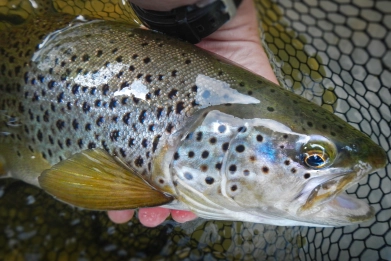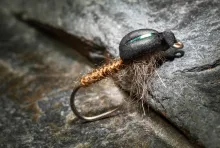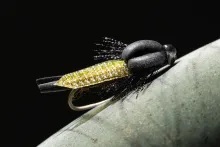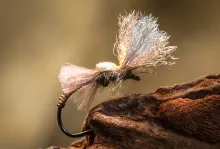An extended body caddis pupa tied with latex ribbon - the al dente tagliatelle of fly tying materials.
Nymph skin, the latex ribbon that looks like al dente tagliatelle, was popularised by Steve Thornton in the late nineties with his Ammonite Nymph and a variety of caddis pupa patterns. It’s good stuff for tying lots of different flies. The standard method is to taper one end, tie in at the back of a hook, wind forward in half-overlapping turns and voila, you have a segmented body.
Don’t get me wrong, this is all good, but there’s a lot more you can do with some stretchy latex. It can also be used to make very effective and naturalistic detached bodies for tying nymphs or pupae. It’s simple and you get a nicely segmented body of the desired size on a small hook. Very sneaky and stealthy.
If you try and tie a detached nymph skin body directly onto a needle, you’ll find that in can be difficult, if not impossible, to get it off the needle intact when you are done. The stretchy latex wants to grab the needle and pulling can stretch the body out of shape or pull it apart.
The trick is to use a foundation that separates the latex from the needle and easily slides off once the body is completed, hollow braided fly line backing works well for this. You can tie detached bodies using just nymph skin or combine it with other materials like organza ribbon to make some great looking bodies. There’s a section in my book Fly Couture that covers the process in detail.
Making a floating detached body is a simple matter or tying in a strip of foam along the top of the braid and wrapping over it with nymph skin. Stretching the skin at the beginning and end of the body forms a taper at either end.
It’s a versatile pattern that can be fished in lakes or rivers wherever there are caddis pupae, which in practice means pretty much anywhere. I fish it as a single fly on a long leader cast out and allowed to sit or drift. If that doesn’t attract any interest, I’ll pull the fly under and let it float back up to the surface. With a soft squishy body and a small hook takes are usually confident and the fish either hook themselves or hang on long enough for you to set the hook.
- Log in to post comments
















Alternatives to Nymph Skin
Bodies look great and lots of options for variants. In case you don't have any of the original strips, Hareline now offers a product via US retailers called Kiley's Nymph Skins which seems identical to the original Virtual Nymph product. Or you can cut various industrial protective gloves into thin strips and use as substitutes for the commercial products. A US tier, Safet Nikocevic, has been demonstating how to do this for many years at the International Fly Tying Symposium in New Jersey.